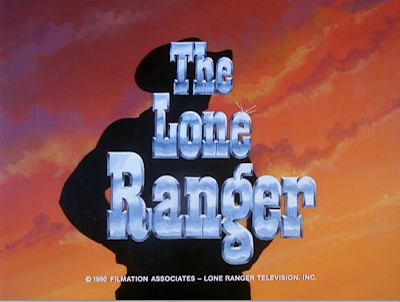This episode of The Tarzan/Lone Ranger Adventure Hour (from Filmation) and the year 1980 again features that "masked rider of the plains," and sends him on adventures to his long-standing theme song: the William Tell Overture.
In "Hanga, The Night Monster," The Lone Ranger (William Conrad) and Tonto are celebrating the "new trail of the iron horse," the joining of the west and east components of the transcontinental railroad. Upon seeing the Lone Ranger's diagram of the railroad drawn roughly in the sand, Tonto wonders if the railroad means "the end" for the horse.
Stalwart Silver replies by kicking dust over the map, and obliterating it.
Meanwhile, Chinese workers on the transcontinental railroad working night and day come face-to-face with a strange, fire breathing monster. This glowing monstrosity -- this dragon -- seems to swallow workers whole, and threatens the entirety of the project to join the components of the railroad.
The Lone Ranger and Tonto arrive on the scene and must determine the truth regarding this creature apparently from myth...
In "Hanga, the Night Monster," the Lone Ranger and Tonto must discern the truth involving competing railroad companies, and which one has the most to gain by slowing down progress of the first transcontinental line. The monster, Hanga, turns out to be a man-made device -- a train car covered in glowing paint -- that is designed specifically to scare off the Chinese workers, who are doing all the back-breaking labor.
The education coda that follows concerns the importance of Chinese workers in the history of the American railroad.
Like "The Runaway," this story sees a link between the Lone Ranger and the emerging Age of the Railroad, a factor which would eventually ameliorate the "frontier" aspect of the Old West, and bring civilization to that territory permanently, thus, after a fashion, negating the necessity of a man like the Lone Ranger.
The Legend of the Lone Ranger (1981) and the new The Lone Ranger (2013), apparently, also both involve the railroad and trains as crucial plot elements.











No comments:
Post a Comment